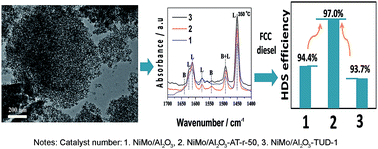Synthesis of aluminum-modified 3D mesoporous TUD-1 materials and their hydrotreating performance of FCC diesel†
Abstract
Aluminum-modified 3D mesoporous TUD-1 materials (denoted as Al-TUD-1, abbreviated as AT) were successfully synthesized by a sol–gel method using TEA and TEAOH as the co-template. Several analytical techniques such as XRD, N2 physisorption, TEM, NH3-TPD, H2-TPR and UV-vis DRS were used to characterize the typical physico-chemical properties of Al2O3–AT composite supports and their corresponding catalysts. The characterization results indicated that most of the aluminum species was partially incorporated into the framework of the TUD-1 silicate network, and the as-synthesized material had a uniform pore size distribution, high surface area and high pore volume. The catalytic performances of hydrotreating were evaluated by using PetroChina Hohhot petrochemical company FCC diesel as the feedstock. Among the series catalysts of NiMo/Al2O3–AT-m, the catalyst with 30 m% AT in the support exhibited the highest HDS conversion, which was as high as 97.42%. Moreover, the influence factors in the synthetic process of the Al modified TUD-1 such as Si/Al ratio, heat treatment time and heat temperature were systematically studied and the corresponding supported NiMo series catalysts showed good hydrotreating performances. The catalyst with the Si/Al ratio of 50 in AT, heat treatment time of 18 h and heat treatment temperature of 180 °C exhibited the highest HDS (97.56%) and HDN (99.63%) efficiencies, respectively.


 Please wait while we load your content...
Please wait while we load your content...